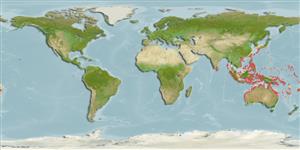分類 / Names
俗名 | 同種異名 | Catalog of Fishes(屬, 種) | ITIS | CoL | WoRMS | Cloffa
Teleostei >
Gobiiformes (Gobies)
鱸形目 (Gobies) >
Gobiidae (Gobies)
鰕虎魚科 (Gobies) > Gobiinae
Etymology: Gobiodon: Latin, gobius = gudgeon + Greek, odous = teeth (Ref. 45335).
Environment: milieu / climate zone / depth range / distribution range
生態學
海洋 礁區魚類; 深度上下限 0 - 8 m (Ref. 94251).
分布
國家 | FAO區域 | 生態系 | 發現紀錄 | Point map | 簡介 | Faunafri
West Pacific: Indonesia, Cocos Is., Japan (Ryukyu Is.), Micronesia (Ponape), Australia and Papua New Guinea.
大小 / 重量 / 年齡
Maturity: Lm ? range ? - ? cm
Max length : 5.4 cm TL 雄魚/尚未辨別雌雄; (Ref. 11344)
簡短描述
檢索表 | 型態特徵 | 形態測量圖
背棘 (總數) : 7; 背的軟條 (總數) : 10 - 11; 臀棘: 1; 臀鰭軟條: 8 - 10; 脊椎骨: 26. This species possess many reddish spots/stripes on a yellow-green or sky-blue body; when alive or freshly-collected, it can be distinguished from similar reddish-spotted/lined congeners (G. aoyagii and G. histrio), by having the following set of details in color: 5-6 (usually 5) vertical reddish bars on head and pectoral-fin base; bars on cheek and operculum relatively short, usually not or barely reaching dorsally beyond a level of dorsal margin of eye; 3-8 longitudinal series of rounded or longitudinally elongate scarlet/reddish spots on body, sometimes continuous and forming longitudinal stripes; dorsal, anal and caudal fins are pale yellow with very narrow black distal margins; absence of a black spot at dorsoposterior corner of operculum. In alcohol-preserved specimens, all reddish spots are largely or entirely faded, but this species can still be distinguished from congeners by having a deep, inflected interopercle-isthmus groove; a series of minute non-imbricate cycloid scales on midlateral body; 6-7 upper or lower unsegmented caudal-fin rays; absence of a distinct dusky spot at dorsoposterior corner of operculum. Urogenital papilla in males are more narrowed distally and nearly triangular, while is females it is broader and nearly rectangular (Ref. 94251).
Facultative air-breathing (Ref. 126274); This species is observed to be found among branches of table-like corals, usually Acropora nasuta, also A. valida, A. millepora (the coarse branched form) and sometimes
A. tenuis (Ref. 94251).
Life cycle and mating behavior
成熟度 | 繁殖 | 產卵場 | 卵 | 孕卵數 | 仔魚
Bi-directional sex change has been confirmed for this species (Ref. 103751).
Shibukawa, K., Suzuki, T. and M. Aizawa, 2013. Gobiodon aoyagii, a new coral goby (Actinopterygii, Gobiidae, Gobiinae) from the West Pacific, with redescription of a similarly colored Congener Gobiodon erythrospilus Bleeker, 1875. Bull. Nat. Mus. Nat. Sci. 39(3):143-165. (Ref. 94251)
IUCN 瀕危狀態 (Ref. 130435: Version 2024-1)
人類使用
工具
特別的報告
下載 XML
網路資源
Estimates based on models
Preferred temperature (Ref.
123201): 24.6 - 29.3, mean 28.5 °C (based on 1991 cells).
Phylogenetic diversity index (Ref.
82804): PD
50 = 0.5000 [Uniqueness, from 0.5 = low to 2.0 = high].
Bayesian length-weight: a=0.01995 (0.00906 - 0.04395), b=3.01 (2.83 - 3.19), in cm total length, based on all LWR estimates for this body shape (Ref.
93245).
營養階層 (Ref.
69278): 3.4 ±0.5 se; based on size and trophs of closest relatives
回復力 (Ref.
120179): 高度, 族群倍增時間少於 15個月 (Preliminary K or Fecundity.).
Fishing Vulnerability (Ref.
59153): Low vulnerability (10 of 100).
Nutrients (Ref.
124155): Calcium = 207 [89, 434] mg/100g; Iron = 1.03 [0.49, 2.13] mg/100g; Protein = 18 [16, 20] %; Omega3 = 0.111 [0.043, 0.230] g/100g; Selenium = 19.7 [8.8, 44.3] μg/100g; VitaminA = 92.3 [22.1, 375.0] μg/100g; Zinc = 2.23 [1.36, 3.55] mg/100g (wet weight);
